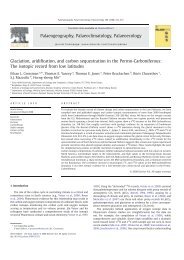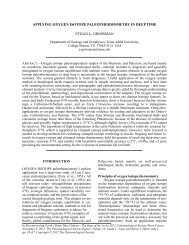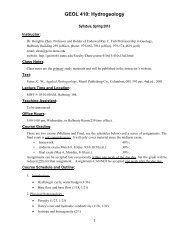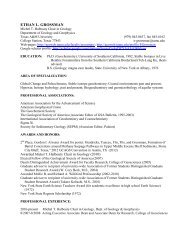Soils Geomorphology Pedology and Soil Geomorpholgy
Soils Geomorphology Pedology and Soil Geomorpholgy
Soils Geomorphology Pedology and Soil Geomorpholgy
You also want an ePaper? Increase the reach of your titles
YUMPU automatically turns print PDFs into web optimized ePapers that Google loves.
<strong><strong>Soil</strong>s</strong> <strong>Geomorphology</strong><br />
Bruce Herbert<br />
Geology & Geophysics<br />
EG: <strong>Pedology</strong><br />
<strong>Pedology</strong> <strong>and</strong> <strong>Soil</strong> <strong>Geomorpholgy</strong><br />
<br />
<br />
<strong>Pedology</strong>: the science devoted to underst<strong>and</strong>ing how soils<br />
developed, relationships to environment, <strong>and</strong> their geography<br />
<strong><strong>Soil</strong>s</strong>: why are they unique<br />
-Hans Jenny: soils unique because they represent the “meeting<br />
ground” between the atmosphere, lithosphere, biosphere, <strong>and</strong><br />
hydrosphere<br />
<br />
<strong><strong>Soil</strong>s</strong> are dynamic,especially under conditions of changing<br />
climate <strong>and</strong> vegetation<br />
EG: <strong>Pedology</strong>
<strong><strong>Soil</strong>s</strong>: Definitions<br />
<br />
<br />
<br />
Unconsolidated material overlying<br />
bedrock (geologist)<br />
Can dig with h<strong>and</strong> tools (engineer)<br />
Transported<br />
Residual<br />
Ability to support plant growth<br />
(pedologist)<br />
Houston Black - Texas State <strong>Soil</strong><br />
http://soils.usda.gov/<br />
EG: <strong>Pedology</strong><br />
<strong>Soil</strong> Terms<br />
<br />
<br />
<br />
Pedon: a soil individual<br />
whose size is about 1<br />
m 2 , but whose<br />
boundaries are often<br />
hard to define<br />
<strong>Soil</strong> Profile: sequence<br />
of layers, or horizons,<br />
from the l<strong>and</strong> surface<br />
which are distinct in<br />
physical <strong>and</strong> chemical<br />
characteristics<br />
Parent Material: the<br />
earth materials in which<br />
the soil develops. At<br />
beginning, soils tend to<br />
be little altered parent<br />
material<br />
<strong>Soil</strong> profile - in Jemez Canyon, NM<br />
http://www.glorietageo.com/images.html<br />
EG: <strong>Pedology</strong>
<strong>Soil</strong> Terms<br />
<br />
<br />
<br />
<br />
Horizons: unique layers: the eluvial<br />
horizon, the illuvial horizon<br />
Eluviation: removal of materials<br />
chemically, with changes chemical<br />
changes in movement.<br />
Illuviation: deposition of chemically<br />
altered materials in lower horizon<br />
Translocation: movement without<br />
chemical alteration<br />
http://www.cst.cmich.edu/users/Franc1M/esc334/images/origin%20of%20soil/profile.gif<br />
EG: <strong>Pedology</strong><br />
<strong>Soil</strong> Maps<br />
Brazos County Generalized <strong>Soil</strong> Map<br />
http://soils.usda.gov/survey/online_surveys/texas/<br />
EG: <strong>Pedology</strong>
<strong>Soil</strong> Profile (Master Horizons)<br />
<br />
<br />
<br />
<br />
<br />
<br />
<br />
O—mostly partially decomposed organic<br />
matter<br />
A—mineral <strong>and</strong> organic horizon<br />
E—loss of clay, Fe, Al, organics (eluviation)<br />
B horizon of accumulation (illuviation)<br />
Clay—argillic<br />
Sodium—natric<br />
Fe + Al—spodic<br />
C—partially weathered parent material<br />
(unconsolidated or consolidated)<br />
R—rock<br />
K—calcium carbonate<br />
EG: <strong>Pedology</strong><br />
<strong>Soil</strong> Characteristics: Physical<br />
<br />
<br />
<br />
Structure: how peds are arranged.<br />
Particle Size/grain size = amount of s<strong>and</strong>, silt, clay in soil.<br />
Determines reactivity, permeability, bearing strength, etc.<br />
Types of horizons present, their thickness, total depth of soil profile<br />
<strong>Soil</strong> colloids tend to<br />
clump together into<br />
larger particles,<br />
producing the soil<br />
structure.<br />
http://www.unc.edu/co<br />
urses/2005ss2/geog/0<br />
10/001/<strong>Soil</strong>%20Format<br />
ion/<strong>Soil</strong>%20Formation.<br />
htm<br />
EG: <strong>Pedology</strong>
<strong>Soil</strong><br />
Characteristics:<br />
<strong>Soil</strong> Texture<br />
The soil texture is a fundamental property of a soil, determining the limits of drainage, water availability<br />
<strong>and</strong> fertility. S<strong>and</strong>y soils: readily drained, light <strong>and</strong> easy to work, warms rapidly in spring, chemically<br />
infertile. Clay soils: easily waterlogged, heavy, stays cool, fertile (many nutrients available). Loam soils:-<br />
mix of s<strong>and</strong> <strong>and</strong> clay soil, usually best for agricultural purposes. These have some ribbon-forming<br />
properties <strong>and</strong> tend to feel a bit gritty. They also tend to leave a whitish residue (the silt) on your<br />
fingers when you rub this type of soil.<br />
http://www.unc.edu/courses/2005ss2/geog/010/001/<strong>Soil</strong>%20Formation/<strong>Soil</strong>%20Formation.htm<br />
EG: <strong>Pedology</strong><br />
<strong>Soil</strong> Characteristics:<br />
Water Holding Capacity<br />
<br />
<br />
<br />
Available water capacity:<br />
difference between field<br />
capacity <strong>and</strong> permanent<br />
wilting point<br />
Field capacity: maximum<br />
amount of water that can<br />
be held against gravity<br />
drainage (adhesion <strong>and</strong><br />
surface tension)<br />
Permanent wilting point:<br />
remaining water is so<br />
tightly held by tension that<br />
plants cannot extract it.<br />
http://www.ext.colostate.edu/pubs/garden/gardimg/07754f02.jpg<br />
EG: <strong>Pedology</strong>
<strong>Soil</strong> Characteristics: Water Holding Capacity<br />
http://www.cpc.ncep.noaa.gov/soilmst/img/curr.w.full.daily.gif<br />
EG: <strong>Pedology</strong><br />
<strong>Soil</strong> Characteristics: Water Holding Capacity<br />
http://www.cpc.ncep.noaa.gov/soilmst/img/curr.w.anom.daily.gif<br />
EG: <strong>Pedology</strong>
<strong>Soil</strong> Characteristics: Chemical<br />
<br />
<br />
<br />
<br />
<br />
Color<br />
red = iron oxide<br />
black = organic matter,<br />
maganese oxides<br />
green-gray = reducing<br />
pH: soil reaction: whether<br />
acidic, neutral, or alkaline<br />
CEC: cation exchange capacity<br />
<strong>Soil</strong> organic matter<br />
Mineralogy, especially in the<br />
clay fraction<br />
www.uwsp.edu/.../images/biosphere/soils/ph.jpg<br />
EG: <strong>Pedology</strong><br />
<strong>Soil</strong><br />
Characteristics:<br />
Chemical<br />
EG: <strong>Pedology</strong>
<strong>Soil</strong> Forming Factors<br />
<br />
<br />
<br />
Five soil forming factors:<br />
Parent material: weathering, texture, mineralogy<br />
Time: degree of weathering, sediment movement<br />
Climate: degree of weathering, biotics<br />
Organisms: degree of weathering, organic matter accumulation<br />
Relief: microclimates, hydrology<br />
Affect soil characteristics<br />
Comparisons of soils may allow:<br />
Relative dating; important for reconstructing past sequences of<br />
geomorphic events<br />
Estimating past environmental conditions that may have<br />
influenced geomorphic processes<br />
EG: <strong>Pedology</strong><br />
<strong>Soil</strong> Forming Factors: Climate<br />
EG: <strong>Pedology</strong>
<strong>Soil</strong> Forming Factors: Parent Material<br />
<br />
<br />
<br />
Resistance of parent<br />
material to weathering<br />
Texture<br />
Mineral stability<br />
Bowen’s Reaction Series<br />
Secondary Mineral Formation<br />
EG: <strong>Pedology</strong><br />
Classification (<strong>Soil</strong> Taxonomy—USDA)<br />
Order (12)<br />
Suborder (63)<br />
Great Group (319)<br />
Subgroup (2484)<br />
Family (8000)<br />
-- Series (19,000)<br />
The second edition of <strong>Soil</strong> Taxonomy, A Basic System of <strong>Soil</strong> Classification for Making <strong>and</strong><br />
Interpreting <strong>Soil</strong> Surveys is now available here in PDF format for printing or viewing.<br />
http://soils.usda.gov/technical/classification/taxonomy/<br />
The 9th edition of Keys to <strong>Soil</strong> Taxonomy is available now in Adobe Acrobat or Microsoft<br />
Word format.<br />
http://soils.usda.gov/technical/classification/tax_keys/<br />
EG: <strong>Pedology</strong>
Major <strong>Soil</strong> Orders: Spodosols<br />
The central concept of Spodosols is that of soils in which amorphous mixtures of organic matter<br />
<strong>and</strong> aluminum, with or without iron, have accumulated. In undisturbed soils there is normally an<br />
overlying eluvial horizon, generally gray to light gray in color, that has the color of more or less<br />
uncoated quartz.<br />
EG: <strong>Pedology</strong><br />
Major <strong>Soil</strong> Orders: Alfisols<br />
The central concept of Alfisols is that of soils that have an argillic, a k<strong>and</strong>ic, or a natric<br />
horizon <strong>and</strong> a base saturation of 35% or greater. They typically have an ochric epipedon,<br />
but may have an umbric epipedon. They may also have a petrocalcic horizon, a fragipan or<br />
a duripan.<br />
EG: <strong>Pedology</strong>
Major <strong>Soil</strong> Orders: Mollisols<br />
The central concept of Mollisols is that of soils that have a dark colored surface<br />
horizon <strong>and</strong> are base rich. Nearly all have a mollic epipedon. Many also have an<br />
argillic or natric horizon or a calcic horizon. A few have an albic horizon. Some also<br />
have a duripan or a petrocalic horizon.<br />
EG: <strong>Pedology</strong><br />
Major <strong>Soil</strong> Orders: Ultisols<br />
The central concept of Ultisols is that of soils that have a horizon that contains an<br />
appreciable amount of translocated silicate clay (an argillic or k<strong>and</strong>ic horizon) <strong>and</strong> few<br />
bases (base saturation less than 35 percent). Base saturation in most Ultisols decreases<br />
with depth.<br />
EG: <strong>Pedology</strong>
Major <strong>Soil</strong> Orders: Aridisols<br />
The central concept of Aridisols is that of soils that are too dry for mesophytic plants to<br />
grow.<br />
EG: <strong>Pedology</strong><br />
Major <strong>Soil</strong> Orders: Oxisols<br />
The central concept of Oxisols is that of soils of the tropical <strong>and</strong> subtropical regions.<br />
They have gentle slopes on surfaces of great age. They are mixtures of quartz, kaolin,<br />
free oxides, <strong>and</strong> organic matter. For the most part they are nearly featureless soils<br />
without clearly marked horizons. Differences in properties with depth are so gradual that<br />
horizon boundaries are generally arbitrary.<br />
EG: <strong>Pedology</strong>
Major <strong>Soil</strong> Orders: Vertisols<br />
The central concept of Vertisols is that of soils that have a high content of expending<br />
clay <strong>and</strong> that have at some time of the year deep wide cracks. They shrink when drying<br />
<strong>and</strong> swell when they become wetter.<br />
EG: <strong>Pedology</strong><br />
Major <strong>Soil</strong> Orders: Incetisols<br />
The central concept of Inceptisols is that of soils of humid <strong>and</strong> subhumid regions that<br />
have altered horizons that have lost bases or iron <strong>and</strong> aluminum but retain some<br />
weatherable minerals. They do not have an illuvial horizon enriched with either silicate<br />
clay or with an amorphous mixture of aluminum <strong>and</strong> organic carbon.<br />
EG: <strong>Pedology</strong>
Less Common <strong>Soil</strong> Orders<br />
<br />
<br />
<br />
<br />
Entisols: soils too young to have mature characteristics<br />
Histosols: organic soils<br />
Gelsols: soils with permafrost within 100 cm of the surface<br />
Andisols: immature volcanic soils<br />
EG: <strong>Pedology</strong>








